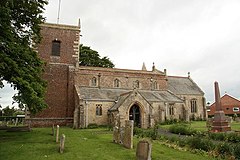Butterwick, Lincolnshire
| Butterwick | |
|---|---|
 Church of St Andrew, Butterwick | |
Location within Lincolnshire | |
| Population | 1,365 (2021 census) |
| OS grid reference | TF387448 |
| • London | 100 mi (160 km) S |
| Civil parish |
|
| District | |
| Shire county | |
| Region | |
| Country | England |
| Sovereign state | United Kingdom |
| Post town | Boston |
| Postcode district | PE22 |
| Police | Lincolnshire |
| Fire | Lincolnshire |
| Ambulance | East Midlands |
| UK Parliament | |
Butterwick is a village and civil parish in the Borough of Boston, Lincolnshire, England, It is situated approximately 3 miles (5 km) east from the market town of Boston.
Butterwick is one of eighteen civil parishes which, together with Boston, form the Borough of Boston local government arrangement, in place since a reorganisation of 1 April 1974, which resulted from the Local Government Act 1972. The parish forms part of the Coastal electoral ward.
Hitherto, the parish had formed part of Boston Rural District in the Parts of Holland. Holland was one of the three divisions (formally known as parts) of the traditional county of Lincolnshire. Since the 1888 Local Government Act Holland had been, in most respects, a county in itself.
On the nearby coast, Freiston Shore, is a wildlife reserve covering approximately 1,400 acres (570 ha) of brackish lagoon, and a natural and reconstituted salt marsh.[citation needed]
The name comes from the Old English "butere" and "wic" meaning a meeting place, or a butter specialised farm.[1]
Butterwick Grade I listed Anglican church is dedicated to St Andrew.[2] It contains Early English style arcades and font. In 1916 Cox reported that an ancient sycamore, planted in 1653, stood in the churchyard.[3]
Ordnance survey maps from the 1920s show an agricultural tramway network running west from the village in a u-shape to Butterwick Grange. Such tramways often used WW1 narrow gauge trench railway equipment to allow year around access to soft fenland fields.
Butterwick Mill, a Grade II listed tower mill built in 1871,[4] has been partially restored by Lincolnshire County Council.[citation needed]
The village also has a public house (The Five Bells), a Church of England primary school, fish and chip shop, park, and small businesses.
| Year | Population[5] |
|---|---|
| 1801 | 229 |
| 1811 | 240 |
| 1821 | 482 |
| 1831 | 504 |
| 1841 | 579 |
| 1851 | 625 |
| 1881 | 533 |
| 1891 | 473 |
| 1901 | 473 |
| 1911 | 523 |
| 1921 | 498 |
| 1931 | 507 |
| 1941 | N/A (World War II) |
| 1951 | 563 |
| 1961 | 552 |
| 2001 | 1,403 |
| 2011 | 1,302 |
| 2021 | 1,365[6] |
References
[edit]- ^ "Butterwick". Institute for Name Studies. University of Nottingham. Retrieved 18 September 2011.[permanent dead link]
- ^ Historic England. "Church of St Andrew (1308528)". National Heritage List for England. Retrieved 1 August 2011.
- ^ Cox, J. Charles (1916) Lincolnshire p. 90; Methuen & Co. Ltd.
- ^ Historic England. "Butterwick Mill (1062084)". National Heritage List for England. Retrieved 1 August 2011.
- ^ "Butterwick parish population:Vision of Britain".
- ^ "Butterwick (Lincolnshire, East Midlands, United Kingdom) - Population Statistics, Charts, Map, Location, Weather and Web Information". citypopulation.de. Retrieved 16 February 2023.
External links
[edit] Media related to Butterwick, Lincolnshire at Wikimedia Commons
Media related to Butterwick, Lincolnshire at Wikimedia Commons

